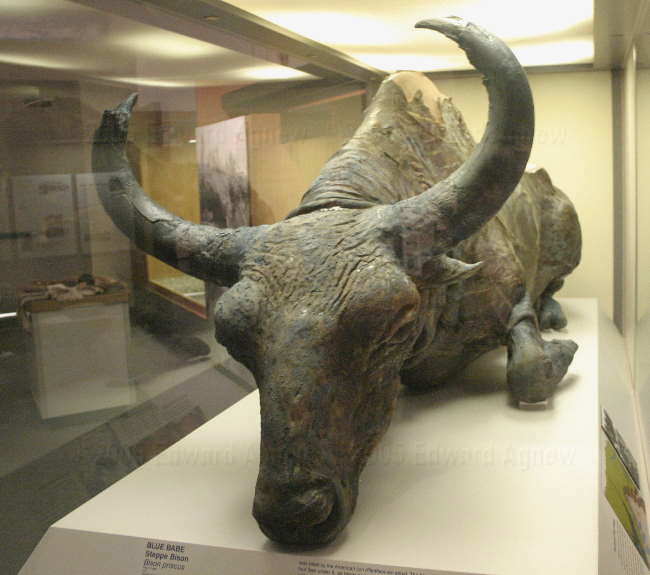|
|
Post by Seijun on Jan 28, 2011 22:34:05 GMT
Frozen mammoths/mastadons are nothing new, but what about other animals? Hairy elephants weren't the only ones living in the ice and snow.
|
|
|
|
Post by simon on Jan 28, 2011 22:51:24 GMT
Frozen mammoths/mastadons are nothing new, but what about other animals? Hairy elephants weren't the only ones living in the ice and snow. Adult female woolly rhino mounted at museum in Krakow, Poland.  The entire carcass was found buried in a mine in extremely oily soil in 1929, which had preserved the skin - but not the hair. |
|
|
|
Post by simon on Jan 28, 2011 22:58:53 GMT
Blue Babe - a 36,000 year old frozen Bison found in Fairbanks in 1979.  |
|
|
|
Post by Dan on Jan 29, 2011 0:10:53 GMT
Wow, I haven't seen these. Thanks for posting, Simon!
|
|
|
|
Post by Godzillasaurus on Jan 30, 2011 15:17:14 GMT
That is incredible I cant believe I have never scene these before!!!
|
|
|
|
Post by Seijun on Jan 30, 2011 20:12:44 GMT
Those are really neat. Any others?
|
|
|
|
Post by mnemosaurus on Jan 30, 2011 20:29:55 GMT
Adult female woolly rhino mounted at museum in Krakow, Poland.  The entire carcass was found buried in a mine in extremely oily soil in 1929, which had preserved the skin - but not the hair.  Wow, the oily soil caused a patina-like effect on the skin of this not-so-woolly-anymore rhino - beautiful! |
|
|
|
Post by zopteryx on Feb 1, 2011 1:32:48 GMT
I wonder if we could find a megatherium, or a saber-tooth? You know, something really different from modern creatures (somewhat).
|
|
|
|
Post by stoneage on Feb 1, 2011 3:31:03 GMT
|
|
Gabe
Full Member
  
Posts: 119
|
Post by Gabe on Feb 1, 2011 3:46:45 GMT
Amazing photos... Thanks!
|
|
|
|
Post by zopteryx on Feb 3, 2011 1:25:33 GMT
Those are very interesting, thank you Stoneage.  Imagine the amount of ecotourism that would be generated by cloning extinct megafauna and reintroducing them to their homelands. I'd love to see a Megalania (or whatever it's called now)! ;D |
|
|
|
Post by Horridus on Feb 3, 2011 2:22:04 GMT
It's either Megalania or Varanus prisca*. I like the former for the very unscientific reason that it won't get lost among the gajillion existing Varanus species  *Should be 'priscus' actually....masculine/feminine and all that...nuts |
|
|
|
Post by dinoguy2 on Feb 4, 2011 0:53:35 GMT
I wonder if we could find a megatherium, or a saber-tooth? You know, something really different from modern creatures (somewhat). Not positive but I don't think those animals lived in tundra areas where it would have been cold enough to freeze them in permafrost. Smilodon and the giant sloths lived in the southern parts of North America, and South America, where the glaciers didn't fully reach. I don't think any are known from Alaska, Siberia etc. where they could have frozen. |
|
|
|
Post by Seijun on Feb 4, 2011 1:48:48 GMT
Surely there would have been some sort of large predator in the tundra areas (?)
|
|
|
|
Post by stoneage on Feb 4, 2011 3:17:26 GMT
Surely there would have been some sort of large predator in the tundra areas (?)  The Cave Lion and the Short-Faced Bear have been found in Perma-Frost! |
|
|
|
Post by Seijun on Feb 4, 2011 3:27:20 GMT
I assume just the bones?
|
|
|
|
Post by sbell on Feb 4, 2011 4:09:11 GMT
Surely there would have been some sort of large predator in the tundra areas (?)  The Cave Lion and the Short-Faced Bear have been found in Perma-Frost! They lived in the areas where permafrost is now found, but I can't seem to find any reference to a preserved-in-permafrost specimen, which is what the point of this discussion is. If a cave lion has been found this way, then that should put to rest the discussion of whether or not they had manes. It would also answer whether or not the sf bear was really somehow different in its overall build (recent research suggests that it is neither all that long-legged, not even that short-of-faced). |
|
|
|
Post by stoneage on Feb 4, 2011 4:41:04 GMT
 The Cave Lion and the Short-Faced Bear have been found in Perma-Frost! They lived in the areas where permafrost is now found, but I can't seem to find any reference to a preserved-in-permafrost specimen, which is what the point of this discussion is. If a cave lion has been found this way, then that should put to rest the discussion of whether or not they had manes. It would also answer whether or not the sf bear was really somehow different in its overall build (recent research suggests that it is neither all that long-legged, not even that short-of-faced).  There are Paleolitihic cave paintings, ivory carvings, and clay busts, which indicate that cave lions had protruding ears, tufted tails, and that at least some males had a "ruff" or primitive mane around their neck. |
|